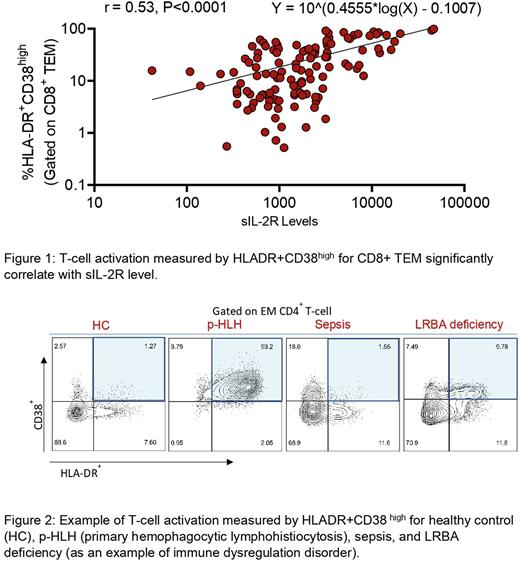Abstract
Introduction: T cell activation is the hallmark of several hyperinflammatory states such as HLH and immune dysregulation disorders like LRBA deficiency. Identifying T-cell activation and quantifying the amplitude of T-cell activation is critical for diagnosis, management, and monitoring treatment response in patients with hyperinflammatory and immune regulatory disorders. Soluble Interleukin 2 Receptor (sIL2R) is one of the established systemic T-cell activation markers for diagnosing and monitoring HLH and other hyperinflammatory disorders. However, the clinical availability of sIL2R testing is limited, and it may not be a reliable marker of T-cell activation in patients with eosinophilia and T-cell lymphoma. A recent study by Chaturvedi et.al has demonstrated the utility of flow-based T-cell activation assessment in differentiating HLH from sepsis. However, its utility in defining and quantifying T-cell activation across the hyperinflammatory spectrum and its correlation with sIL2R has not yet been established.
Methods: A total of 125 samples were collected either at disease onset (n = 81) or at follow-up (n = 44) from 85 human subjects. Paired plasma sIL2R and T-cell activation markers were prospectively evaluated in patients with suspected HLH (n = 79) or immune dysregulation disorders (n = 46). Out of 85 patients, 21 patients were diagnosed with either primary HLH (p-HLH), Epstein-Barr virus infection-associated HLH (EBV-HLH), malignancy-associated HLH (m-HLH), or macrophage activation syndrome (MAS). The rest of the patients were diagnosed with either sepsis, multisystem inflammatory syndrome in children (MIS-C), hyperinflammatory conditions, hepatitis, or acute liver failure. Flow cytometry-based T-cell activation was evaluated in different T-cell sub-compartments by the co-expression of HLA-DR and CD38 surface markers. Plasma sIL2R levels and CXCL9 (a chemokine driven by IFN-g) were determined independently in CLIA certified clinical diagnostic laboratory. Research personnel who analyzed the flow cytometry data were blinded to the corresponding sIL2R test results and clinical diagnosis. Longitudinal follow-up was performed for a subset of patients with HLH or immune dysregulation with evidence of T-cell activation. We also evaluated T-cell activation in 30 healthy controls (HC) to establish a reference range. In addition, the correlation between T-cell activation markers with plasma levels of sIL2R and CXCL9 was also investigated.
Results: Evaluation of T-cell activation measured by HLADR+CD38high in HCs and different hyperinflammatory/ immune regulatory disorders revealed that HCs have less than 8% of T-cell activation in CD8+ T effector memory (TEM) and less than 4% for activation in the CD4+ TEM compartments. In patients with suspected hyperinflammatory/ immune regulatory disorders, we identified significant correlation of direct T-cell activation with plasma sIL2R level in different T-cell subsets, CD3 (r = 0.44, p < 0.0001), CD4 (r = 0.41, p < 0.0001), CD8 (r = 0.45, p <0.001), CD4 TEM (T effector memory) (r =0.53, p < 0.001), and CD8 TEM (r =0.53, p < 0.0001). The strongest correlation between HLADR+CD38high with sIL2R level was noted in CD4+ TEM and CD8+ TEM compartments (Figure 1). The correlation is even more robust at disease onset (r = 0.69, p <0.0001 for CD4+ TEM and r = 0.64, p < 0.0001 for CD8+ TEM). However, at follow up, only activation in CD8+ TEM correlated with sIL2R levels (r = 0.4, p = 0.0069). Moreover, T-cell activation in CD8+ TEM correlated well with CXCL9 and ferritin levels. Among the cohort of patients with the confirmed final diagnosis, we found that both p-HLH and EBV-HLH have CD8+ TEM activation > 70%, whereas MAS and m-HLH have a median T cell activation of 37.8% (10.5-67) and 48.1% (4.9-80.6) respectively. Immune dysregulation patients had T-cell activation range from 8.0 to 46.0 % and sepsis group has 0% to 10.8% (Figure 2). A similar trend was also validated using corresponding plasma sIL2R levels in different hyperinflammatory states.
Conclusions: Flow cytometry-based direct assessment of HLADR+CD38high in T cells subsets can reliably quantify T-cell activation and strongly correlate with sIL2R level across a spectrum of different hyperinflammatory and immune dysregulations disorders. If validated, this could be used as a real-time assessment of T-cell activation at disease onset and monitoring response to therapy.
Disclosures
Chandrakasan:SOBI: Consultancy.
Author notes
Asterisk with author names denotes non-ASH members.


This feature is available to Subscribers Only
Sign In or Create an Account Close Modal